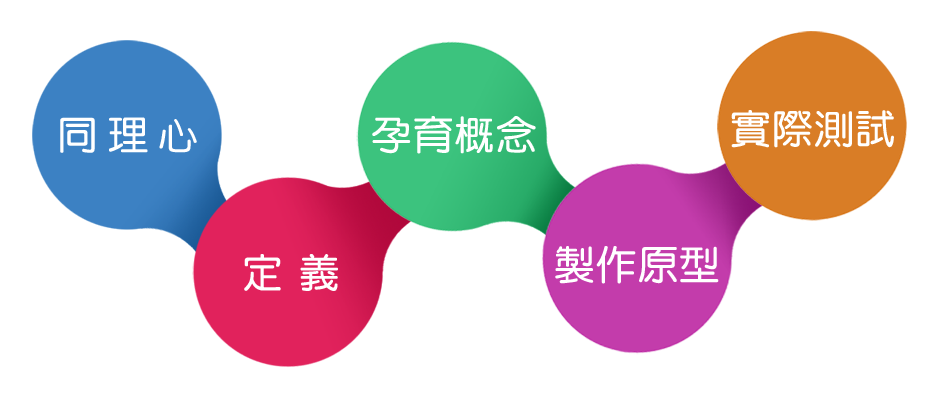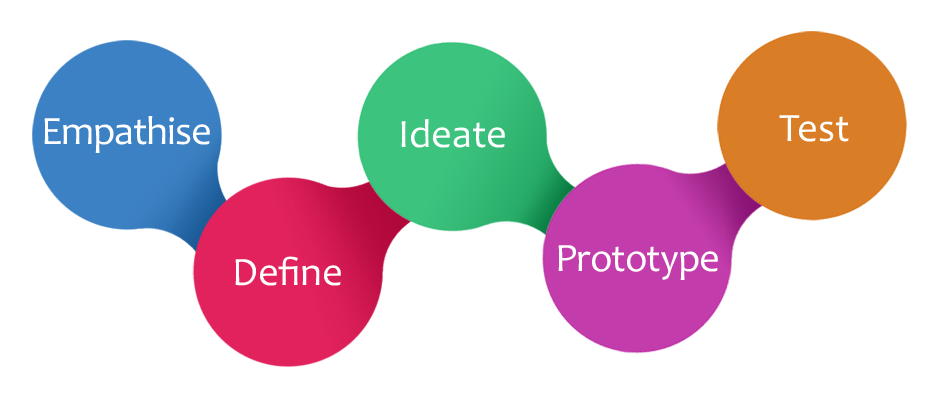設計思考:達致更創新和更佳解決方案的方法與過程
甚麼是設計思考?
一直以來,個人感覺及以人為本的概念都主宰著設計師的創作。他們把人類的情感、行為和個性融入產品。以往我們對設計的理解和應用只局限於物件本身的設計和風格,現在卻更著重於其服務和整體經驗;而設計思考的概念亦已走出設計或創新行業的框框,被廣泛應用在不同的行業裏,包括教育。設計思考是一種以人為本的解難方法和過程,讓人們使用設計為本的技巧為複雜的問題尋求各項務實的解決方案。
[su_row]
[su_column size="1/2"]
設計思考的過程
據IDEO (一所國際設計顧問公司) 的創辦人兼主席David Kelley稱,設計思考的過程包括五個步驟,即「同理心」、「定義」、「孕育概念」、「製作原型」及「實際測試」(Gillian,2012)。本文會以由香港専業教育學院工程學科師生共同研發的太陽能動力車SOPHIE為例,說明設計思考的過程。
[/su_column]
[su_column size="1/2"]
 設計思考的五個步驟
(圖像由教學中心提供,2016)
設計思考的五個步驟
(圖像由教學中心提供,2016)
[/su_column]
[/su_row]
同理心
設計思考能成功地應用於解決科技、商業和社會的問題,是因為它重視使用者的需要。設計思考的本質就是「設計師以以人為本的精神達致創新」(Turnali,2015)。這種「以人為本」的做法源自「設身處地」的思維原則,意味著設計思考者需先了解使用者和/或持份者的處境和文化背景,透過研究,例如直接觀察和收集質性數據等方法,幫助理解來龍去脈,明白使用者的「故事」。這表示設計思考者會走入社區,「投入」、「觀察」、「接觸」、「聆聽」和「尋找故事」,繼而「詢問原因」和「建立關係」,去理解使用者隱含的需要和問題的根源(Wise,2016)。以太陽能動力車SOPHIE為例,小組除了研究世界太陽能車挑戰賽(WSC)的要求和澳洲政府的法例外,更親身觀察賽事,以了解車手在比賽時的駕駛需要。
定義
設計思考者利用那些「故事」,加上他們從研究所得的見解,確定要解決的問題和所面對的限制,便會就問題思考解決方案。於SOPHIE的故事中,計劃被定義為:老師和學生須在一個特定的時間和預算內,運用専業知識和技能,完成一輛能符合世界太陽能車挑戰賽和政府要求的太陽能車。計劃於2009年展開,目的是鼓勵學生以專業的工程和設計知識創造一架環保汽車(Cheung,2015)。
孕育概念
斷定了問題後,設計思考者會腦震盪新思路,並挑戰一些假設。他們會根據現實世界和真實體驗去探索解決方案。在構思階段,設計思考者想法萬千。Linus Pauling指出:「要有好的點子,最好的辦法是要有很多的點子」 (Creative Something, 2012)。設計思考之所以有價值是因為這個過程鼓勵人們去探索不同的方案,創造那些前所未有的新選擇。為了創造 SOPHIE,香港專業教育學院SOPHIE團隊孕育概念,並評估能源、經濟和汽車賽事等多方面因素。在這個階段,他們運用多元思維技能,如思維圖、類比和關聯等方法去探索不同的可能性。
製作原型
設計思考其中一個特別之處,是它並非追求完美。這方法強調實踐和嘗試。設計思考者反覆製作原型和尋求相關人士的意見,直至最好的解決方案出現。在這階段,設計思考者會想像使用者從新設計中得到的經驗,也考慮到所需的技術。製作原型包括實體及數碼形式。例如 SOPHIE 的製作原型就是經過不斷改良,由紙張、紙板、發泡膠等發展而成的。
實際測試
製作原型後,接著就實際測試其可能出現的結果。為此,設計思考者會邀請相關的專家和持份者評審製作原型並給予回饋:究竟有關想法是否可行?哪些地方應該改進?如果想法行不通,設計思考者會再修改,並根據意見製作另一個原型。孕育概念、製作原型及實際測試這過程不斷重覆,直至找到最好的方案。在這三個階段裏, SOPHIE 團隊對結果作分析、數據解讀、評估和測試,終於在2010年成功創造第一架 SOPHIE。設計思考的過程帶來更廣闊的視野角度,豐富學與教的體驗。
[su_row]
[su_column size="1/2"]
啟示
職業專才教育(VPET)裝備學生廿一世紀的技能,其中包括利用創意及創新思維技巧,為問題尋求務實及以使用者為本的解決方案。設計思考可說是掌握廿一世紀技能的一項重要工具,因為使用者必須以同理心出發,以全面的角度去解決複雜的問題。在過去數年間,教育工作者見證設計思考在教育中的應用,他們都在探索如何把設計思考應用到不同的學科。作為廿一世紀的教育工作者,我們都應鼓勵學生成為創造者和創新者,運用設計思考技巧,為問題尋求不同的務實解決方案。
[/su_column]
[su_column size="1/2"]
 21世紀學生的能力
(相片由 SOPHIE 研發小組提供,2015)
21世紀學生的能力
(相片由 SOPHIE 研發小組提供,2015)
[/su_column]
[/su_row]
參考文獻:
Cheung, E. (2015). Solar car turns heads during Hong Kong test run. Hong Kong Free Press. Retrieved August 19, 2016 from
https://www.hongkongfp.com/2015/06/29/unusual-solar-car-draws-attention-during-its-venture-on-hk-road/
Creative Something. (2012). The science of having more good ideas. Retrieved August 22, 2016 from
http://creativesomething.net/post/34293929732/the-science-of-having-more-good-ideas
Gillian. (2012, July 27). David Kelley: How to build your creative confidence (Video File). Retrieved August 19, 2016 from
https://humancentreddesign.wordpress.com/2012/07/27/david-kelley-how-to-build-your-creative-confidence/
Turnali, K. (2015). What is design thinking? Forbes. Retrieved August 19, 2016 from
http://www.forbes.com/sites/sap/2015/05/10/what-is-design-thinking/#3c66196d3c18
Wise, S. (2016). Design thinking in education: empathy, challenge, discovery, and sharing. Edutopia. Retrieved August 19, 2016 from
http://www.edutopia.org/blog/design-thinking-empathy-challenge-discovery-sharing-susie-wise<
Design Thinking: Method and Process Leading to Greater Creativity and Better Solution
What is Design Thinking?
Designers have long been using their sensibility and taking human-centred approach to design. They incorporate human’s emotion, behaviour and personality into the design of products. While our understanding and application of design have evolved from objects and styles to services and holistic experiences, the concept of design thinking (DT) has been widely adopted by the design or innovation sector and across different sectors including education. DT is a methodology and process of problem solving led by a human-centred approach. The process, which involves empathising, defining, ideating, prototyping and testing, allows people to employ design-based techniques to generate multiple pragmatic solutions to complex problems.
[su_row]
[su_column size="1/2"]
The Process of Design Thinking
According to David Kelley, the Founder and Chairman of IDEO (an international design and consulting firm), the process of DT includes five steps, namely “empathise”, “define”, “ideate”, “prototype” and “test” (Gillian, 2012). In this article, the solar-powered car, SOPHIE, co-developed by teachers and students of the Engineering Discipline of Hong Kong Institute of Vocational Education (IVE) is used as an example to illustrate the process of DT.
[/su_column]
[su_column size="1/2"]
 The Five Steps of Design Thinking
(Image courtesy of CLT, 2016)
The Five Steps of Design Thinking
(Image courtesy of CLT, 2016)
[/su_column]
[/su_row]
Empathise
DT has been successfully applied to problems with technology, business and social innovations because it focuses on the needs of users. Its nature as a human-centred approach to innovation that draws from the designer was emphasised (Turnali, 2015). This “human-centred” approach is led by the classic philosophy of “walking in someone else’s shoes”, which implies that design thinkers would first understand the context and culture of the users and/or the stakeholders. This understanding could be formed earlier by conducting research, such as direct observation and collection of qualitative data, which produces the story people empathise with. This means design thinkers may go out to the community to “immerse”, “observe”, “engage”, “listen”, “seek stories”, “ask why” and “build relationships” in order to understand the implicit needs and root cause of the situations (Wise, 2016). Taking the example of SOPHIE, the team has studied the World Solar Challenge (WSC) requirements and Australian Government’s laws and regulations, and observed the race in-person so as to incubate the needs of users.
Define
With the stories, design thinkers would define what the problem is and what the issues and constraints are. Together with the insights they drew from their research, they would work on the solutions to the problem. For the story of SOPHIE, the project is defined as: to create a solar car that meets WSC and Government requirements based on staff and students’ vocational knowledge and skills within a given timeframe and budget. The project began in 2009 with the aim of encouraging students to create an environmentally friendly solar car with the professional engineering and design knowledge (Cheung, 2015).
Ideate
After the problem is diagnosed, design thinkers would generate, brainstorm new ideas, and challenge assumptions. They would iterate solutions based on real world and authentic experience. In the ideation phase, design thinkers would generate a myriad of ideas. Linus Pauling stated that “the best way to have good ideas is to have lots of ideas” (Creative Something, 2012). What is valued about DT is that the process encourages people to explore the alternatives and to create options that have not existed before. For the creation of SOPHIE, the team incubated, and evaluated ideas in terms of energy, budget, car race and so on. In this phase, divergent thinking skills, such as mind mapping, analogical thinking and force connection are applied to explore possibilities.
Prototype
One of the distinctive characteristics of DT is that the method does not seek perfection. This method focuses on doing and trying. It is cyclical to build prototypes of the solutions and ask the feedback from the stakeholders until design thinkers come up with the best solution. In this phase, design thinkers would envision the experience of the users with the new design and may also consider the technology used. Prototyping includes both physical and digital formats. For example, prototypes in forms of papers, cardboards and foams were made for the development of SOPHIE.
Test
Rapidly prototyping would be followed by testing for the possible outcome. For this, design thinkers would invite people who are experts and stakeholders in the field to review the prototype and give feedback: Does the idea work? What should be improved? If the idea does not work, design thinkers would go back to modify the ideas and make another prototype based on the feedback. The process of ideating, prototyping and testing are iterating until the best solution is found. During the process of these three phases, the IVE SOHPIE Team analysed and interpreted data, evaluated and tested the outcome. The first SOPHIE was created in 2010 by the IVE SOPHIE Team. The process of DT entails the development and integration of wider perspectives on learning and teaching experience.
[su_row]
[su_column size="1/2"]
Implications
Vocational and professional education and training (VPET) has been equipping students with 21st century skills which include the application of creative and innovative thinking skills to draw pragmatic and user-centred solutions to problem solving. DT is a great tool for acquiring 21st century skills, as participants must solve complex problems by a holistic approach which starts with empathy. Over the past few years, educators have witnessed the application of DT in education and many practitioners are exploring the application of DT process into different academic disciplines. As 21st century educators, why don’t we encourage our students to be creators and innovators by using DT to explore multiple, pragmatic solutions to problems?
[/su_column]
[su_column size="1/2"]
 Solar Powered Electric Vehicle, SOPHIE V
(Photo Courtesy: IVE Sophie Team, 2015)
Solar Powered Electric Vehicle, SOPHIE V
(Photo Courtesy: IVE Sophie Team, 2015)
[/su_column]
[/su_row]
References:
Cheung, E. (2015). Solar car turns heads during Hong Kong test run. Hong Kong Free Press. Retrieved August 19, 2016 from
https://www.hongkongfp.com/2015/06/29/unusual-solar-car-draws-attention-during-its-venture-on-hk-road/
Creative Something. (2012). The science of having more good ideas. Retrieved August 22, 2016 from
http://creativesomething.net/post/34293929732/the-science-of-having-more-good-ideas
Gillian. (2012, July 27). David Kelley: How to build your creative confidence (Video File). Retrieved August 19, 2016 from
https://humancentreddesign.wordpress.com/2012/07/27/david-kelley-how-to-build-your-creative-confidence/
Turnali, K. (2015). What is design thinking? Forbes. Retrieved August 19, 2016 from
http://www.forbes.com/sites/sap/2015/05/10/what-is-design-thinking/#3c66196d3c18
Wise, S. (2016). Design thinking in education: empathy, challenge, discovery, and sharing. Edutopia. Retrieved August 19, 2016 from
http://www.edutopia.org/blog/design-thinking-empathy-challenge-discovery-sharing-susie-wise
 設計思考的五個步驟
(圖像由教學中心提供,2016)
設計思考的五個步驟
(圖像由教學中心提供,2016) 21世紀學生的能力
(相片由 SOPHIE 研發小組提供,2015)
21世紀學生的能力
(相片由 SOPHIE 研發小組提供,2015) The Five Steps of Design Thinking
(Image courtesy of CLT, 2016)
The Five Steps of Design Thinking
(Image courtesy of CLT, 2016) Solar Powered Electric Vehicle, SOPHIE V
(Photo Courtesy: IVE Sophie Team, 2015)
Solar Powered Electric Vehicle, SOPHIE V
(Photo Courtesy: IVE Sophie Team, 2015)